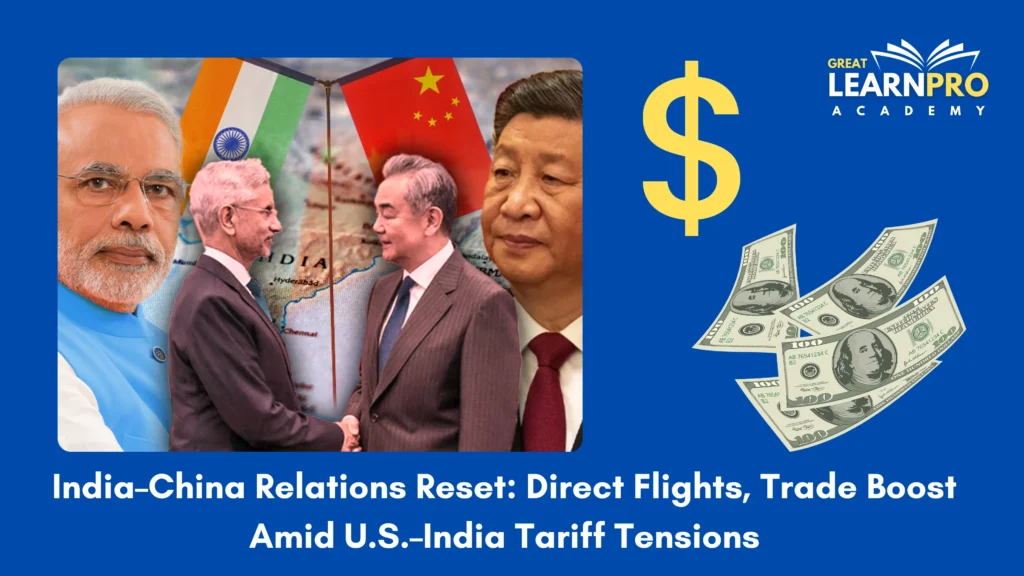
The past fortnight has seen two parallel arcs in New Delhi’s diplomacy. On one track, U.S.–India ties have entered a stormy patch, with Washington announcing an extra 25% tariff on Indian goods, lifting duties on many exports up to 50% among the highest the U.S. levies on any partner. The move, tied to India’s continued purchases of Russian oil, has rattled markets and exporters and marks a serious rupture after stalled talks earlier in August.
On the other track, India and China have begun deliberately easing frictions. In mid-August, Chinese Foreign Minister Wang Yi visited New Delhi for talks with National Security Advisor Ajit Doval as the two Special Representatives on the boundary question. The official statements flagged a structured dialogue and confidence-building, signalling that both sides are willing to compartmentalize contentious issues and restore practical cooperation.
What changed?
Three years after the border crisis upended relations, the two Asian giants are testing a limited reset grounded in connectivity, trade facilitation and people-to-people links. As part of the recent outreach:
- Direct commercial flights between India and China are set to resume, with both capitals working on an updated Air Services Agreement. This is significant for business travel, students, and supply chains that have relied on circuitous routes since the pandemic and the freeze in ties.
- The sides will boost trade and investment, including reopening border trade at designated points and easing visas for business, media and tourists steps designed to un-kink commerce and rebuild trust at the ground level.
- Reporting and analysis also point to reciprocal gestures such as India resuming visa services for Chinese tourists and progress on facilitating religious pilgrimages in Tibet (Kailash–Manasarovar), which function as symbolic barometers of normalcy.
Individually, each step is modest; together, they amount to a pragmatic stabilization not a grand rapprochement, but a way to cap downside risks.
Why now?
Geopolitics and economics are pushing both sides toward a managed détente:
- Trade reality check. Despite political chill, China remains a critical node in Indian supply chains (electronics, APIs, capital goods). Restoring direct flights and easing visas lowers transaction costs and supports investment flows that neither side wants to forgo.
- Strategic hedging amid U.S. tariffs. With U.S.–India trade ties under acute stress due to the new duties, New Delhi has incentives to diversify risk and stabilize relations elsewhere especially with a neighbor that is both competitor and indispensable trading partner. Analysts and officials alike describe the tariff shock as a meaningful drag on growth and exports.
- Border management imperative. The Special Representatives’ meeting underscores a shared interest in preventing escalation along the Line of Actual Control while broader normalization inches forward. Even incremental clarity on patrol protocols or local disengagement reduces the chances of tactical miscalculation.
What the thaw is—and isn’t
- It is a function-first reset: resume flights, reopen trade nodes, smooth visas, and re-institutionalize dialogue. These are reversible but confidence-building steps that can be expanded if politics allows.
- It is not a resolution of the boundary dispute or a return to pre-2020 normal. Until there is durable progress on the ground, strategic suspicion will persist on both sides; the reset is bounded.
Implications for India’s foreign policy
- Multi-alignment in practice. New Delhi’s outreach to Beijing, even as it pushes back against U.S. tariffs, reflects India’s familiar “issue-based partnerships” approach: align where interests converge, compartmentalize where they don’t. The same week that India warned Pakistan of flood risks on humanitarian grounds another instance of pragmatic signaling New Delhi was also calibrating its China channel.
- Economic shock absorption. If U.S. duties bite into sectors from gems and jewelry to textiles, smoother China logistics (flights, visas, border trade) could partially offset supply-chain friction and keep export-oriented firms competitive in other markets. But it won’t fully neutralize a 50% tariff wall in the U.S.
- Space for incremental trust-building. People-to-people ties students, tourism, pilgrimages often lead broader political normalization. If the current track holds, expect measured expansions in air capacity, business delegations, and local trading posts over the next quarters.
The bottom line
U.S.–India frictions have accelerated India’s hedging instinct, creating an opening for India–China de-escalation focused on connectivity and commerce. The tangible moves resuming direct flights, easing visas, and reopening border trade points don’t erase deep structural mistrust, but they lower the temperature and rebuild habits of cooperation. If the tariff shock in Washington persists, expect New Delhi to keep banking small wins with Beijing while keeping an eye on the unresolved boundary question.
Sources:
- https://timesofindia.indiatimes.com/business/india-business/severe-trade-shock-donald-trumps-tariffs-to-hit-66-of-indias-exports-to-us-china-vietnam-set-to-gain/articleshow/123515790.cms?utm_
- https://www.reuters.com/world/china/india-china-agree-resume-direct-flights-boost-business-links-2025-08-19/?utm_
- https://www.mea.gov.in/press-releases.htm?dtl%2F40016%2FVisit_of_Chinas_Foreign_Minister_and_Special_Representative_on_the_IndiaChina_boundary_question=&utm_
- https://time.com/7311553/india-china-mending-ties-trump-us/?utm_
More Current Affairs: https://learnproacademy.in/updates/
